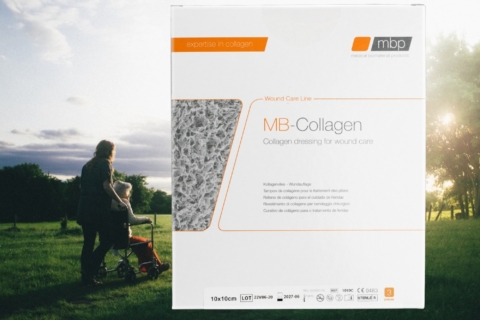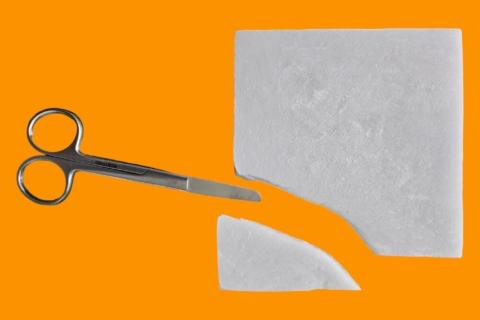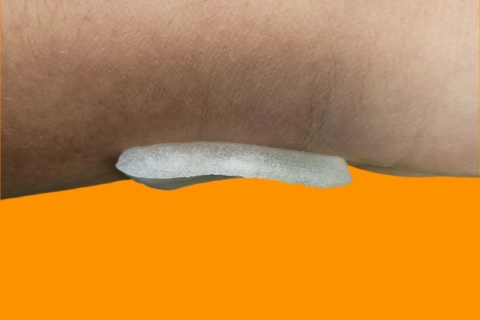Wound care management
Collagen wound dressings
The MBP product MB-Collagen Use of collagen in chronic wounds
To stimulate wound healing, collagen fleeces are used as wound dressings on non-infected burns and areas with wound healing disorders (chronic wounds). The collagen fleece accelerates and supports wound healing through its haemostatic effect and stimulates the release of various growth factors essential for wound healing such as PDGF and TGFβ by activating platelets.
MB collagen provides a matrix into which the exuding blood or wound secretion (exudate) penetrates. Platelets are activated by contact with the collagen. The now changed surface form leads to aggregation and clumping. At the same time, the release of coagulation factors is initiated, which initiates plasmatic blood coagulation, which leads to vessel occlusion with the formation of a fibrin scaffold. Haemostasis is accelerated by the platelet-activating effect of collagen.
At the same time, the wound dressing provides a capillary suction effect due to the porous structure of the collagen sponge and thus ensures the absorption of the wound secretion. The wound secretion dissolves the porous structure of the wound dressing and releases the native collagen. This has an accelerating effect on the formation of new granulation tissue in the granulation phase. In chronic wounds, the exogenous collagen binds the activity of excess metalloproteases and thereby enables the body’s own collagen synthesis, which leads to the build-up of the extracellular matrix of the granulation tissue.
The collagen supplied thus indirectly influences the regeneration and epithelisation phase by stimulating and protecting the body’s own collagen synthesis, whereby epithelisation progresses rapidly. As a competing substrate, the exogenous collagen reduces the degradation of endogenous collagen by proteases that prevent the build-up of an extracellular matrix – a prerequisite for the free mobility of cells involved in this process (e.g. leukocytes, macrophages, fibroblasts, epithelial cells) – and formation of granulation tissue.

Collagen wound dressing




MB-Collagen (Collagen Wound dressing)
MB-Collagen is a sponge-like wound dressing made from porcine collagen for the treatment of traumatic and poorly healing wounds such as decubitus ulcers or leg ulcers.
Properties
- Promotes wound healing by binding excess collagen-degrading enzymes (MMPs)
- leads to chemotactic settlement of fibroblasts in the wound bed and
- Build-up of granulation tissue with own collagen synthesis
- Microbial and mechanical barrier function
- Fully resorbable
- Adheres well to the wound bed
- Adheres well to the wound bed
Fields of application
Collagen wound dressings are used in a variety of medical settings to help heal wounds. Here are some examples of where collagen wound dressings are used:
- Hospital, inpatient care
- Medical practice, outpatient care
- Wound Care Centers
- Care facilities
- Rehabilitation centres
Practical application description
MB-Collagen has a sponge-like, soft shape – unless otherwise prescribed by the doctor, a collagen sponge corresponding to the size of the wound is placed on the moist wound under aseptic conditions. MB collagen can be fixed with a non-woven compress or a gauze compress. The frequency of dressing changes depends on the amount of wound secretion:
- In case of heavy secretion: several times a day
- For moderate secretion: 1 x daily
- In case of weak exudation: after several days (provided that no signs of inflammation are present).
- If exudation is very weak or absent, it becomes necessary to moisten MB-Collagen with a physiological sodium chloride or a Ringer’s solution.
Customer feedback 2023 (Health care and nursing staff, specialist therapist for wounds ICW, rehabilitation centre, Germany): First application of MB-Collagen in a patient (50 years):
“We saw a very positive healing process during the treatment with MB-Collagen. More areas of active tissue were visible on the wound surface. The material was easy to apply and fit well into the wound cavity, especially after light moistening. The wound remained ideally moist even after standing for 4 days. We recommended further treatment with MB Collagen in our wound transition.”

- Medical device class III (Regulation (EU) 2017/745)
- Source of collagen: porcin
- Collagen wound dressing
- Easy handling
- Easy storage at ≤ 24°C
- Has excellent biocompatibility
- No risk of human virus transmission
- Manufactured in Germany
Purpose
MB-Collagen is a collagen dressing for wound care. It is indicated for the following clinical pictures: Non-infected wounds with wound healing disorders; wounds with secondary wound healing in the granulation phase; wounds in the epithelialisation phase (e.g. leg ulcers, decubital ulcers; split skin removal sites, burn wounds, secondary healing wounds, etc.).
Article number (REF) / size / sales unit/ UDI-DI
- 0505C / 5*5 cm / 3 pieces per Unit / 426023091001
- 0510C / 5*10 cm / 3 pieces per Unit / 426023091002
- 1010C / 10*10 cm / 3 pieces per Unit / 426023091003

